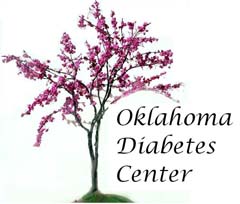
|
:: HOME / Mission statement
Oklahoma Diabetes Center
MISSION STATEMENT
 The mission of the Oklahoma Diabetes Center is to promote (1) clinical and basic sciences research related to diabetes and its complications, (2) education of
the public and professionals in all matters related to diabetes, including
diabetes prevention, and (3) optimal diabetes care for the people of
Oklahoma. The mission of the Oklahoma Diabetes Center is to promote (1) clinical and basic sciences research related to diabetes and its complications, (2) education of
the public and professionals in all matters related to diabetes, including
diabetes prevention, and (3) optimal diabetes care for the people of
Oklahoma.
- Research: To promote and conduct cutting-edge clinical and basic science research, through peer-reviewed research protocols and clinical trials. Thereby, to contribute to the growth of diabetes research activity and the mentoring of young investigators at OUHSC (current funding for diabetes research in the Section of Endocrinology and Diabetes exceeds $2 million per year). To promote use of the NIH-funded OUHSC General Clinical Research Center.
- Education and Prevention: To educate individuals with diabetes, health professionals, health care systems, policy makers, and the general public about diabetes and its complications. To sustain educational programs at all professional levels in medicine, nursing, dietetics, pharmacy, podiatry, and other health-related disciplines. To extend educational activities throughout the Oklahoma City and Tulsa Health Sciences campuses, and beyond into the general community.
- Clinical Care: To lead by example, promoting, through a team approach, the highest standards of health care for people with diabetes and related conditions, including pre-diabetes and gestational diabetes.
BACKGROUND
Diabetes is a leading cause of heart attacks, strokes, amputations, blindness,
kidney failure, and fetal mortality. The National Cholesterol Education Panel
recently defined diabetes as a "cardiovascular risk equivalent". This means
that an apparently healthy person with diabetes is at the same risk for a future
heart attack as a non-diabetic person who has already had a heart attack. People
with diabetes are 3-6 times more likely to suffer a heart attack than those
without, and in the presence of diabetes, heart attack victims suffer an exceptionally
high immediate mortality: only 50% reach the hospital alive. Recent surveys
have indicated that patients, their families, the general public, and health
professionals of all types are inadequately aware of these issues. Standards
of care for people with diabetes are changing quickly, as new knowledge about
prevention of the disease and its complications, and new treatments, emerge.
Improved medications, interventions, and new devices for insulin delivery and
self-glucose monitoring are appearing rapidly, but necessitate more aggressive
medical care.
In the state of Oklahoma, diabetes affects over 190,000 adults. It is conservatively
estimated that a similar number of people have undiagnosed diabetes, and that
400,000 others have pre-diabetes. The prevalence of diabetes increases with advancing
age and is higher in minority populations, including Native Americans, African
Americans, and Hispanic Americans who together constitute almost half the population
of the state. The high prevalence of diabetes among older adults and minorities
is well illustrated by the fact that 10,000 of the 40,000 veterans who attend
the Oklahoma City VA Medical Center have a diagnosis of diabetes, and as many
more have insulin resistance. Diabetes has increased to epidemic proportions
in the state of Oklahoma and in the nation over the past decade. As is the case
elsewhere, provision of care lags far behind established standards for most patients.
We have established the Oklahoma Diabetes Center on the OUHSC campus in Oklahoma
City, and plan to extend this effort to the OU Tulsa campus and throughout the
state. The Center has been accredited by the American Diabetes Association as
a recognized center of excellence for diabetes education.
GOAL 1: Diabetes Research
 We have established a nationally recognized center for
diabetes research at OUHSC, with over 25 peer-reviewed grants brought to
the Section of Endocrinology within the past three years. In addition, there
are many investigators in a number of departments of OU Health Sciences Center
(e.g. cell biology, ophthalmology, biochemistry, and nephrology) and in the
Oklahoma Medical Research Foundation whose work is relevant to diabetes.
Our strategy has been to establish a core group of researchers in the Section
of Endocrinology and Diabetes, and to amplify productivity by maximizing
inter-departmental collaborations for both clinical and basic science. We have established a nationally recognized center for
diabetes research at OUHSC, with over 25 peer-reviewed grants brought to
the Section of Endocrinology within the past three years. In addition, there
are many investigators in a number of departments of OU Health Sciences Center
(e.g. cell biology, ophthalmology, biochemistry, and nephrology) and in the
Oklahoma Medical Research Foundation whose work is relevant to diabetes.
Our strategy has been to establish a core group of researchers in the Section
of Endocrinology and Diabetes, and to amplify productivity by maximizing
inter-departmental collaborations for both clinical and basic science.
GOALS 2 and 3: Education and Patient Care
 The educational and clinical goals of the Oklahoma Diabetes
Center are as follows: The educational and clinical goals of the Oklahoma Diabetes
Center are as follows:
- To provide a comprehensive program of education and management which adheres to the latest standards of care for people with type 1 and type 2 diabetes, using a team approach.
- To prevent the progression of eye, kidney, nerve, heart, brain, and leg vascular complications in patients with diabetes.
- To collaborate with related specialties, including pediatrics and obstetrics to reduce the impact of diabetes on future generations.
- To use this center as an educational tool for other diabetes health care providers throughout the state, and as resource for essential clinical research.
- To serve as a model program for the training of medical and graduate students, house staff, endocrine fellows, visiting physicians and other health professionals.
- To improve screening to detect undiagnosed diabetes, and to prevent diabetes before it develops.
- To promote knowledge and awareness about diabetes and its prevention in the general community.
- To influence public policy in matters related to diabetes and its prevention.
|
